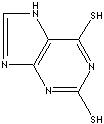PRODUCT IDENTIFICATION

H.S. CODE
TOXICITY
CLASSIFICATION
PHYSICAL AND CHEMICAL PROPERTIES
AUTOIGNITION
NFPA RATINGS
REFRACTIVE INDEX
Stable under ordinary conditions
GENERAL DESCRIPTION AND APPLICATIONS
APPEARANCE
ASSAY
|
|
|
| 2,6-DITHIOPURINE | ||
|
PRODUCT IDENTIFICATION |
||
| CAS NO. | 5437-25-2 |
|
| EINECS NO. | 226-608-8 | |
| FORMULA | C5H4N4S2 | |
| MOL WT. | 184.24 | |
|
H.S. CODE |
||
|
TOXICITY |
|
|
| SYNONYMS | 2,6-Dimercaptopurine; Dithioxanthine; 2,6-purinedithiol; | |
| SMILES |
|
|
|
CLASSIFICATION |
||
|
PHYSICAL AND CHEMICAL PROPERTIES |
||
| PHYSICAL STATE | light yellow powder | |
| MELTING POINT | > 300 C | |
| BOILING POINT | ||
| SPECIFIC GRAVITY | ||
| SOLUBILITY IN WATER | ||
| pH | ||
| VAPOR DENSITY |
|
|
|
AUTOIGNITION |
|
|
|
NFPA RATINGS |
Health: 1; Flammability: 0; Reactivity: 0 | |
|
REFRACTIVE INDEX |
|
|
| FLASH POINT | ||
| STABILITY |
Stable under ordinary conditions |
|
|
GENERAL DESCRIPTION AND APPLICATIONS |
||
| Purine is a heterocyclic compound featured by a fused pyrimidine and imidazole rings composed of carbon and nitrogen atoms. The simplest one is purine itself and the two major purines are adenine(6-Aminopurine) and guanine (2-Amino-6-hydroxypurine). Other important purines are caffeine, uric acid, theobromine, and theophylline. Purine and its analogues are biologically important components of nucleic acids (DNA, RNA) and coenzymes. Mercaptopurines are used in the research of specific toxic action upon cells of special organs. | ||
| SALES SPECIFICATION | ||
|
APPEARANCE |
light yellow powder | |
|
ASSAY |
98.0% min | |
| MELTING POINT | > 300 C | |
| TRANSPORTATION | ||
| PACKING |
|
|
| HAZARD CLASS | Not regulated | |
| UN NO. | ||
| OTHER INFORMATION | ||
| Hazard Symbols: , Risk Phrases: 20/21/22-36/37/38-40, Safety Phrases: 26-27-36/37/39 | ||
|
|
|